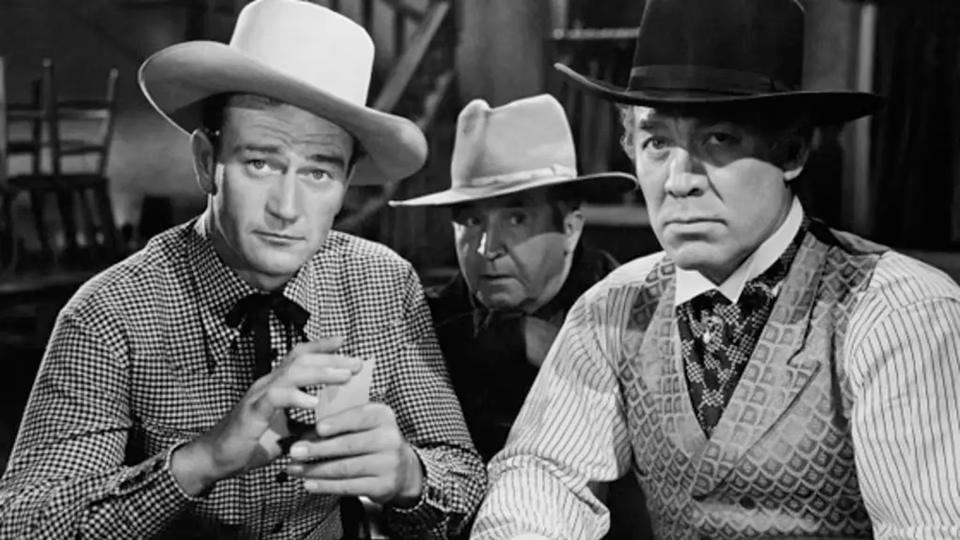Tall in the Saddle

Tall in the Saddle proffers a novel amalgam of the hard-boiled detective story and western.
John Wayne plays a ranch hand who arrives in a small frontier town for a job only to find a corrupt sheriff, a shady judge, and his boss murdered a week prior.
As Wayne sets about asking questions and ruffling feathers in the small town, the script proffers multiple red herrings. Ella Raines plays the femme fatale, a fiery ranch owner who sets her sights on Wayne. She’s good in the part, clad in skin-tight jeans and wielding a pistol, her sultry eyes sending mixed signals fury and desire.
Wayne’s character has edge too, saying early, “I never feel sorry for anything that happens to a woman,” which wins him the support of the stage-driver, played by Gabby Hayes, who becomes his semi-sidekick. But Wayne’s ample charisma and the script’s limiting his misogyny to the above line and his refusal to work for a woman keep his character likable.
The production marked a milestone for Wayne. In John Wayne: The Life and Legend, Scott Eyman quotes Wayne saying the film “was the first picture in which I found the story and made a deal with a studio for its development. I worked at half price at RKO in order to have complete control, regardless of whose names appeared on the titles.” In John Wayne: American, Randy Roberts and James S. Olson counter, “Actually, Duke was paid $6,250 a week for his work—his standard RKO salary—but he undoubtedly did play a part in development.”
Regardless, Wayne’s influence manifests in a supporting cast stacked with Wayne’s friends and former co-stars. Besides Gabby Hayes, Ward Bond plays the judge, and Paul Fix plays a corrupt deputy.
Fix also co-wrote the script, which proffers several choice lines—a hallmark of any good hard-boiled detective story. An early one, at the stage office, has the stage manager warning Wayne that Hayes is a “grumpy old cuss.” Replies Wayne, “I like grumpy old cusses—Hope to live long enough to be one.” Or later, after Wayne has pistol-whipped a drunken would-be assassin and a prissy old lady wails, “I saw you! I saw you strike that poor man!” And Wayne replies, “Yes, ma’am. Just as hard as I could.”
The mystery proves decent, but not on par with the likes of Hammett or Chandler. Director Edwin Marin keeps things moving at a brisk pace—the film clocks in just under ninety minutes—but the script struggles with the third act. After upping the narrative stakes by framing Wayne for a murder, the conclusion underwhelms, requiring an exposition-heavy dump that sees one character explaining the details—Scooby-Doo style—after they’ve been caught. A set-piece climax—or one with more emotional stakes à la The Big Sleep—might have nudged the film into greatness.
Despite this misstep, Tall in the Saddle entertains. Just a decade prior, Wayne and Hayes were churning out low-budget mystery-westerns for Poverty Row studio Monogram. This feels like the movie those oaters aspired to be—with grand mountain vistas, well-dressed sets, a stocked supporting cast, and multi-dimensional characters. It’s a good-but-not-great film that should entertain Wayne’s fans and any western fans partial to the hard-boiled detective genre.